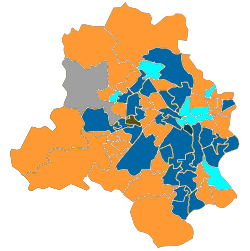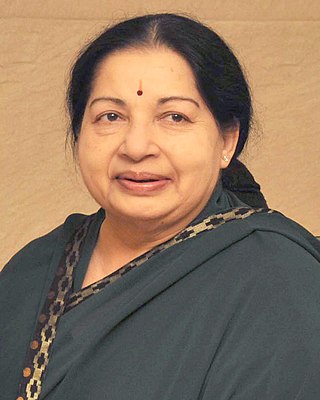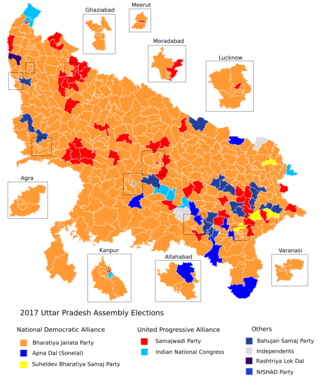
Electronic voting is the standard means of conducting elections using Electronic Voting Machines (EVMs) in India. The system was developed for the Election Commission of India by state-owned Electronics Corporation of India and Bharat Electronics. Starting in the late 1990s, they were introduced in Indian elections in a phased manner.
"None of the above" (NOTA), or none for short, also known as "against all" or a "scratch" vote, is a ballot option in some jurisdictions or organizations, designed to allow the voter to indicate disapproval of the candidates in a voting system. It is based on the principle that consent requires the ability to withhold consent in an election, just as they can by voting "No" on ballot questions. It must be contrasted with "abstention", in which a voter does not cast a ballot.
Voter verifiable paper audit trail (VVPAT) or verified paper record (VPR) is a method of providing feedback to voters using a ballotless voting system. A VVPAT is intended as an independent verification system for voting machines designed to allow voters to verify that their vote was cast correctly, to detect possible election fraud or malfunction, and to provide a means to audit the stored electronic results. It contains the name of the candidate and symbol of the party/individual candidate. While it has gained in use in the United States compared with ballotless voting systems without it, it looks unlikely to overtake hand-marked ballots.
India has a parliamentary system as defined by its constitution, with power distributed between the union government and the states. India's democracy is the largest democracy in the world.
Electronic voting by country varies and may include voting machines in polling places, centralized tallying of paper ballots, and internet voting. Many countries use centralized tallying. Some also use electronic voting machines in polling places. Very few use internet voting. Several countries have tried electronic approaches and stopped because of difficulties or concerns about security and reliability.

Veeravalli Sundaram Sampath served as 18th Chief Election Commissioner (CEC) of the Election Commission of India from 2012 to 2015. He succeeded S. Y. Quraishi as the Chief Election Commissioner on 11 June 2012. Born on 16 January 1950, Sampath retired on 15 January 2015 when he attained 65 years of age.

The Delhi Legislative Assembly election was held on 4 December 2013, with the result announced on 8 December resulting in formation of the Fifth Legislative Assembly of Delhi.

A Legislative Assembly election was held on 25 November 2013 in Madhya Pradesh, India, with the result announced on 8 December. Along with four other state assembly elections, these were the first elections in which the Election Commission of India (ECI) implemented a "None of the above" (NOTA) voting option, allowing the electorate to register a neutral vote but not to outright reject candidates. In a first, the Election Commission of India also appointed Central Awareness Observers, whose main task was to oversee voter awareness and facilitation.

The Mizoram Legislative Assembly election, 2013 was held on 25 November 2013 in all 40 constituencies of the Legislative Assembly of Mizoram. Results were declared on 9 December. The main contest was between incumbent the Indian National Congress and the Mizo National Front led Mizoram Democratic Alliance. Incumbent Chief Minister Pu Lalthanhawla and his party Indian National Congress won a majority and continued in government.

The Legislative Assembly election was held over five phases in Bihar through October–November 2015 before the end of the tenure of the prior Legislative Assembly of Bihar on 29 November 2015.

Noksen is one of the 60 Legislative Assembly constituencies of Nagaland state in India. It is part of Tuensang District and is reserved for candidates belonging to the Scheduled Tribes.

The Fifteenth Legislative Assembly Election was held on 16 May 2016 for the 232 seats of the Legislative Assembly in the state of Tamil Nadu in India. The AIADMK under J. Jayalalithaa won the elections and became the first ruling party to be re-elected in Tamil Nadu since 1984, though with a simple majority. The DMK won half of the seats it contested but its allies performed poorly; notably, the Indian National Congress won 16% of the seats they contested, and the alliance lost due to its poor performance. The votes were counted on 19 May 2016. In the previous election in 2011, AIADMK, under the leadership of Jayalalithaa, won a thumping majority and formed the government, while DMDK chief Vijayakanth served as the Leader of Opposition until January 2016. This was the last election that J. Jayalalithaa and M. Karunanidhi contested, as they both died in 2016 and 2018 respectively.

The election to the 17th Uttar Pradesh Legislative Assembly was held from 11 February to 8 March 2017 in 7 phases. This election saw a voter turnout of 61.11% compared to 59.40% in the previous election.

A Legislative Assembly election was held in the Indian state of Punjab on 4 February 2017 to elect the 117 members of the Fifteenth Punjab Legislative Assembly. The counting of votes was done on 11 March 2017. The ruling pre-election coalition was the alliance comprising the political parties Shiromani Akali Dal and Bharatiya Janata Party and led by Chief Minister Parkash Singh Badal. The voter turnout for the Punjab Assembly election was 77.2% The Indian National Congress led by former Chief Minister Captain Amarinder Singh defeated the ruling alliance and the newcomer Aam Aadmi Party.

The 14th Gujarat Legislative Assembly election, 2017 was held on 9 December 2017 and 14 December 2017 in the Indian state of Gujarat to elect the Members of Legislative Assembly (MLA). The votes were counted on 18 December. All 182 members of the 14th Gujarat Legislative Assembly were elected with the leader of the largest party or coalition expected to become the next chief minister.

The Himachal Pradesh Legislative Assembly election, 2017 was held on 9 November 2017 to elect all 68 members of the Himachal Pradesh Legislative Assembly.

None of the Above, abbreviated as NOTA, has been provided as an option to the voters of India in most elections since 2013. By expressing a preference for none of the above, a citizen can choose not to vote for any candidates who are contesting the elections.

The 2019 Andhra Pradesh Legislative Assembly election were held in the Indian state of Andhra Pradesh on 11 April 2019 for constituting the fifteenth legislative assembly in the state. They were held alongside the 2019 Indian general election.
Bangladesh election commission scandal of 2020 is the revelation of a series of corruption allegations, moral degradation of the commissioners and evidence of gross misconducts before and after the controversial 2018 Bangladeshi general election and 2019 Upazila polls in Bangladesh. Allegations included the misappropriation of around 20 million Bangladeshi taka for imaginary programs, embezzlement of 40.8 million BDT during the recruitment process of election commission staffs, purchasing the electronic voting machine at a higher price than the market rate, usage of extra cars by three election commissioners flouting rules and facilitating continuous and numerous election fraud by not investigating credible allegations of irregularities during the 11th Parliamentary Election and elections in Dhaka North and Dhaka South City Corporations, Khulna City Corporation, and Gazipur City Corporation.

Municipal election were held in Delhi on 4 December 2022 to elect 250 councillors of Municipal Corporation of Delhi. The votes were counted and the results were declared on 7 December 2022.





























